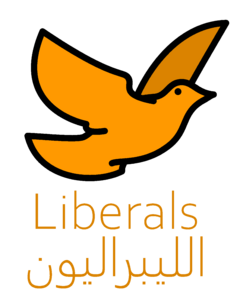Liberal Party (Gassasinia): Difference between revisions
No edit summary |
No edit summary |
||
| Line 26: | Line 26: | ||
The Liberal Party was formed in 1951 as a small splinter group of the now defunct Christian Social Party's left-wing by 12 Members of Parliament, who felt that the Christian Social Party's conservative and Christian-centric ideology was elitist and unsustainable, and that they would eventually tear Gassasinia apart between religious and economic lines. | The Liberal Party was formed in 1951 as a small splinter group of the now defunct Christian Social Party's left-wing by 12 Members of Parliament, who felt that the Christian Social Party's conservative and Christian-centric ideology was elitist and unsustainable, and that they would eventually tear Gassasinia apart between religious and economic lines. | ||
The Liberal Party's policies are based on {{wp|liberal}} ideas, believing in a strong free {{wp|social market economy}} where the government intervenes to provide a | The Liberal Party's policies are based on {{wp|liberal}} ideas, believing in a strong free {{wp|social market economy}} where the government intervenes to provide a {{wp|welfare state}} to keep people out of destitution, along with combating anti-competitive practises to ensure a fair and competitive strong free market economy. Additionally, the Liberal Party holds strong {{wp|social progressive}} ideals, having a progressive stance on social issues such as {{wp|women's rights}}, {{wp|LGBT+ rights}} and {{wp|abortion}}. | ||
The Liberal Party supports a {{wp|civic nationalist}} stance as opposed to an {{wp|Arab Nationalist}} stance, arguing that Gassasinia is a distinct nation of many ethnicities, rather than being part of a single Arab nation. | The Liberal Party supports a {{wp|civic nationalist}} stance as opposed to an {{wp|Arab Nationalist}} stance, arguing that Gassasinia is a distinct nation of many ethnicities, rather than being part of a single Arab nation. | ||
Revision as of 23:09, 25 February 2021
Liberal and Social Progressive Party | |
|---|---|
 | |
| Leader | Ahmed al-Rashid |
| Founded | 5th of February, 1951 |
| Headquarters | 52 Haroun Street, Jabiyah |
| Think tank | Liberal Economic Forum |
| Youth wing | Free Liberal Youth Organisation |
| Women's wing | Liberal Feminist Convention |
| LGBT Wing | LGBTQ+ Liberals |
| Ideology | • Liberalism • Civic Nationalism Factions • Liberal Conservatism • Social Liberalism • Neoliberalism |
| Colours | Orange |
| Slogan | "For a Brighter Future" |
| Political position | Centre to Centre right |
| House of Representatives | 55 / 150
|
| Website | |
| https://LiberalParty.ga | |
The Liberal Party, officially known as the Liberal and Social Progressive Party, is a centrist to centre-right political party in Gassasinia which has held power for much of Gassasinia's history since 1979. As of today, the Gassasinian Liberal Party is currently the largest party in government, ruling in a coalition with the Unionist Labour Party with 55 Members of Parliament in the House of Representatives.
The Liberal Party was formed in 1951 as a small splinter group of the now defunct Christian Social Party's left-wing by 12 Members of Parliament, who felt that the Christian Social Party's conservative and Christian-centric ideology was elitist and unsustainable, and that they would eventually tear Gassasinia apart between religious and economic lines.
The Liberal Party's policies are based on liberal ideas, believing in a strong free social market economy where the government intervenes to provide a welfare state to keep people out of destitution, along with combating anti-competitive practises to ensure a fair and competitive strong free market economy. Additionally, the Liberal Party holds strong social progressive ideals, having a progressive stance on social issues such as women's rights, LGBT+ rights and abortion.
The Liberal Party supports a civic nationalist stance as opposed to an Arab Nationalist stance, arguing that Gassasinia is a distinct nation of many ethnicities, rather than being part of a single Arab nation.
History
Founding (1951)
First General Election and Civil Unrest (1953-1975)
Modern day (1975 Onwards)
Voter Base
Election History
Bold name denotes prime ministership
| Year | Leader | Seats | Government |
|---|---|---|---|
| 1953 | Rita al-Khazen | 12 / 150
|
Opposition |
| 1957 | Rita al-Khazen | 15 / 150
|
Opposition |
| 1961 | Rita al-Khazen | 30 / 150
|
Opposition |
| 1965 | Mounir Ayoub | 35 / 150
|
Junior Partner in coalition with Christian Democrats |
| 1969 | Rita al-Khazen | 30 / 150
|
Opposition |
| 1975 | Rita al-Khazen | 50 / 150
|
Equal coalition partner with Labour and Conservatives. |
| 1979 | Rita al-Khazen | 69 / 150
|
Senior Partner in coalition with Labour |
| 1983 | Farrokh Khoroushi | 90 / 150
|
Government |
| 1987 | Farrokh Khoroushi | 71 / 150
|
Government |
| 1991 | Mounir Ayoub | 50 / 150
|
Senior Partner in coalition with Labour |
| 1995 | Mounir Ayoub | 52 / 150
|
Opposition |
| 1999 | Mounir Ayoub | 59 / 150
|
Opposition |
| 2003 | Edmond Ghulmiyyah | 80 / 150
|
Government |
| 2007 | Khalil Barakat | 88 / 150
|
Government |
| 2011 | Khalil Barakat | 82 / 150
|
Government |
| 2015 | Ahmed al-Rashid | 75 / 150
|
Government |
| 2019 | Ahmed al-Rashid | 55 / 150
|
Senior Partner in coalition with Labour |